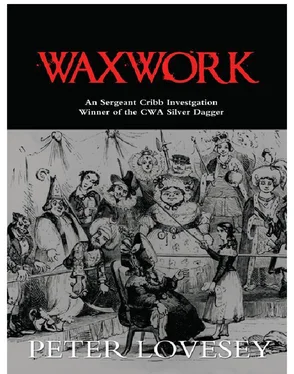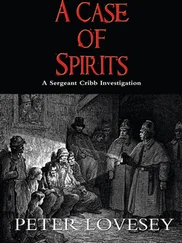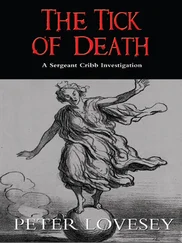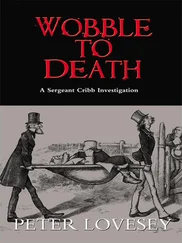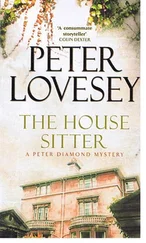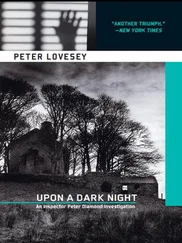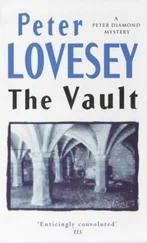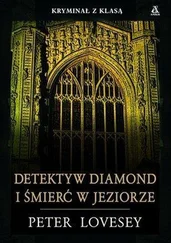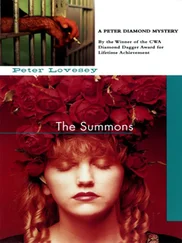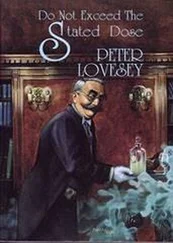Peter Lovesey - Waxwork
Здесь есть возможность читать онлайн «Peter Lovesey - Waxwork» весь текст электронной книги совершенно бесплатно (целиком полную версию без сокращений). В некоторых случаях можно слушать аудио, скачать через торрент в формате fb2 и присутствует краткое содержание. Жанр: Исторический детектив, на английском языке. Описание произведения, (предисловие) а так же отзывы посетителей доступны на портале библиотеки ЛибКат.
- Название:Waxwork
- Автор:
- Жанр:
- Год:неизвестен
- ISBN:нет данных
- Рейтинг книги:3 / 5. Голосов: 1
-
Избранное:Добавить в избранное
- Отзывы:
-
Ваша оценка:
- 60
- 1
- 2
- 3
- 4
- 5
Waxwork: краткое содержание, описание и аннотация
Предлагаем к чтению аннотацию, описание, краткое содержание или предисловие (зависит от того, что написал сам автор книги «Waxwork»). Если вы не нашли необходимую информацию о книге — напишите в комментариях, мы постараемся отыскать её.
Waxwork — читать онлайн бесплатно полную книгу (весь текст) целиком
Ниже представлен текст книги, разбитый по страницам. Система сохранения места последней прочитанной страницы, позволяет с удобством читать онлайн бесплатно книгу «Waxwork», без необходимости каждый раз заново искать на чём Вы остановились. Поставьте закладку, и сможете в любой момент перейти на страницу, на которой закончили чтение.
Интервал:
Закладка:
Dr Pearson Stuart, principal pathologist at Haverstock Hill Infirmary, stated that he had conducted a post mortem examination and found traces of potassium cyanide. Tests he had carried out indicated that the deceased had swallowed approximately 10 grains, which must have induced rapid paralysis and death. Traces of the substance were also found in the cup, which had contained tea. In further evidence Dr Stuart stated that the deceased was three months enceinte at the time of death.
Miss C. Piper, of Kidderpore Avenue, friend of the deceased, stated that she had seen her the day before and found her in a cheerful frame of mind, despite her condition.
Mr Ducane, recalled, said that he had been unaware of the deceased’s condition. He had always found her a reliable employee. In response to a question from the Coroner he stated that potassium cyanide was used in the developing process of photography and a bottle was kept on an open shelf in the studio. It was marked with a poison label.
In his final address the Coroner said that the evidence indicated that the deceased had taken her own life. Although a witness had testified that the deceased had declared herself unconcerned about her condition, it was possible that this was from bravado, to conceal her anxiety. The Coroner took the opportunity to comment that Mr Ducane had demonstrated lamentable negligence in keeping a deadly poison on an open shelf. While he could not have anticipated the tragedy as it had occurred, it was a matter for regret that the agent of Miss Honeycutt’s destruction had been so readily to hand.
The jury, on the coroner’s advice, returned a verdict of suicide.
Towards 5 p.m. the Manchester to Euston Express steamed through South Hampstead on the London and North Western Railway. In a second-class compartment of the third carriage, James Berry folded his newspaper and stood to put it in his Gladstone bag on the luggage rack. Seconds later the train entered Primrose Hill Tunnel. It had been a journey in keeping with the slogan of the L.N.W.R.- Noted for Punctuality, Speed, Smooth Riding, Dustless Tracks, Safety and Comfort. Moreover, not one of his fellow-passengers had recognised him. He had not been bothered with people goggling at him from the corridor or asking idiot questions about the contents of his bag.
Nor were there newspaper reporters on the platform at Euston to pester him. Coming down to London two days earlier had definite advantages. Instead of the usual pantomime of changing cabs and doubling back to give the press the slip, he was able to take a leisurely ride by the direct route to his usual lodging in Wardrobe Place, off Carter Lane, which he always found convenient for his work, being just up the hill from Newgate, right in the shadow of St Paul’s.
The press had never succeeded in tracing him to Mrs Meacham’s. He had made it his rule when visiting the prison to approach it indirectly walking the wrong way up Ludgate Hill and cutting through Bread Street to Cheapside and so down to Newgate Street. He could not avoid them at the prison gate, but they had not the slightest notion where he had come from. When he came out, if he suspected he was being followed, he took a couple of turns round St Paul’s and dodged out by the southwest door, under the clocktower. They didn’t reckon on a hangman visiting a cathedral.
This Wednesday afternoon, though, he arrived in style in Wardrobe Place, and gave the cabman a threepenny tip for helping him with his baggage. Mrs M. had tripe and onions cooking. She greeted him by name. He had never stooped to using a false identity with her. She was a fine woman, no busybody. She had never made inquiry as to the purpose of his visits to London, though he would have been surprised if she had not guessed by now.
After the meal he took a quiet walk round the City and retired early. Thursday would be an important day.
THURSDAY, 21st JUNE
It took him first to Tussaud’s. He travelled by the underground railway to Baker Street, a journey that recaptured in smells and sounds his first visit, as a lad twenty years before. Since then London had shrunk in his mind to Euston Station, Mrs Meacham’s and the execution shed.
He arrived an hour before his appointment, for a good reason. He wanted to take a quiet look round before he met Mr Tussaud. So he paid his shilling at the turnstile like everyone else.
He was pleased to note that the Exhibition had moved from the old Baker Street Rooms into more commodious premises in the Marylebone Road. It was altogether more palatial than he remembered. He mounted a marble staircase into the Hall of Kings, a dazzling place with Richard the Lionheart, Henry and his six wives and every crowned head up to her Imperial Majesty. He felt a tremor of pride at joining them, albeit in a different room. The figures were so finely modelled that he might have walked up and introduced himself. Most riveting of all was a tableau of the Prince of Wales tiger-hunting on his Indian tour. His Royal Highness was up there on a howdah on the back of a stuffed elephant. He was in the attitude of firing both barrels into a tiger which his mount had cleverly pinned to the ground. Berry stood in front of the exhibit and imagined himself aiming the shotgun.
His steps took him next past the statesmen of the civilised world to the Chamber of Horrors, for which he discovered he had to pay sixpence more. That amused him. You could see the Royals and Mr Gladstone, Lord Beaconsfield and President Lincoln for a shilling, but to clap eyes on Burke and Hare and their companions it was a tanner extra. No-one seemed to mind stumping up. Only a few faint hearts waited upstairs while their bolder escorts had sixpennyworth of horrors.
The Chamber was cunningly lit with mantles of coloured glass set low on the wall to give a more horrid aspect to the figures. It was smaller down there than Berry expected. Quite a crush, in fact. The attendant kept asking people to move along as they came to the notorieties in the dock: Palmer, Peace, Kate Webster, Muller, Lefroy and the rest. The lighting apart, nothing had been done to make the figures grotesque. Most of them looked unexceptional. Murderers generally were, in Berry’s experience. There were faces more villainous among the public filing past. The horror lay in discovering that those they had come to see were no different from anyone else.
He soon found Bill Marwood-his effigy, that is to say. It was a marvellous likeness. The eyes had that mild, almost dreamy look and the mouth was set in a downward curve that followed the line of the tobacco-stained moustache. He was in his own black bow and stand-up collar. Marwood to the life. The only fault was that he was holding the pinioning-strap all wrong, more like a butler with a tray than a hangman ready for work. This technicality did not disappoint those who had come to look. Out of interest, Berry lingered close to the figure to eavesdrop on the comments. Curiously, Bill Marwood with his strap had a more chilling effect than all the murderers together. One young woman visibly shuddered at the sight of him. ‘Don’t be alarmed, dearest,’ her chinless escort said. ‘That is only Marwood. He is dead. Berry has the job now.’
He decided against introducing himself.
So, fresh from seeing the show, he went back to the entrance at half past ten to keep his appointment. Mr Joseph Tussaud, grandson of the Exhibition’s founder, his son, John, and five others were waiting in an office. Berry guessed that most of them were there to say that they had shaken him by the hand, which they did, to a man. There was not much said. One of them asked him if it had been raining in Yorkshire. Champagne was served by a liveried footman. Then Mr Tussaud Senior proposed a tour of the Exhibition. It would have been discourteous to disclose that he had just been round it.
Читать дальшеИнтервал:
Закладка:
Похожие книги на «Waxwork»
Представляем Вашему вниманию похожие книги на «Waxwork» списком для выбора. Мы отобрали схожую по названию и смыслу литературу в надежде предоставить читателям больше вариантов отыскать новые, интересные, ещё непрочитанные произведения.
Обсуждение, отзывы о книге «Waxwork» и просто собственные мнения читателей. Оставьте ваши комментарии, напишите, что Вы думаете о произведении, его смысле или главных героях. Укажите что конкретно понравилось, а что нет, и почему Вы так считаете.
